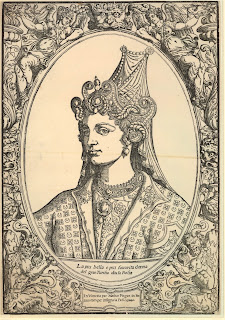 |
| Rosa, Consort of Suleiman, Emperor of the Turks, ca. 1600-70, French School (The Royal Collection) |
 |
| Portrait of Hurrem Sultan titled Rossa Solymanni Vxor, c. 18th century (Topkapi Palace Museum) |
 |
| Titian, La Sultana Rossa, c. 1550 |
 |
| Haseki Hurrem Sultan (La Rossa), c. 1540-1550 Woodcut published by Matteo Pagani (©Trustees of the British Museum |
 |
| Suleyman the Magnificent, c. 1540-50 Woodcut published by Matteo Pagani ©Trustees of the British Museum |
I had written in a previous post about a series of Ottoman Sultans portraits, based on a series made by Nakkas Nigari, that existed in a Venetian collection in the 16th century. These woodcuts published by Matteo Pagani may have similar origins but their influence in later representation of the Sultan and the Sultana can be seen from the 18th century Portrait of Hurrem Sultan in the Topkapi Palace collection.
Suleyman is noted as a 'creative conquerer' who could wield a pen as well as a sword.1 The age of Süleyman which lasted for 46 years from 1520 - 1566 is known as the Ottoman Golden Age where the arts flourished under his patronage and some of the greatest Ottoman artists lived. The great architect Sinan, the poet, thinker and writer, Fuzuli, the polymath artist, mathematician, painter and cartographer, Matrakci Nasuh, and the innovative illuminator Karamemi all lived and worked for the Ottoman Sultan at this time. The Sultan who is referred to as Suleyman the Lawgiver due to having reorganized all the archaic laws of the empire, was also a poet who wrote under the pseudonym of Muhibbi.
Illuminated pages from the Muhibbi Divani, illuminated by Karamemi (Istanbul University Central Library, Rare Manuscripts Department)

Süleyman spent almost a third of this 46 year rule away on campaign. His ardor for Hürrem seems to have been constant which is proven by the love poems he sent to her when he was away. Muhibbi Divani was a book of Suleyman's poems which were written in Talik inscription by the calligrapher Mehmed el-Serif and illuminated with a different design on each page by Karamemi. The entire book is available digitally online to page through on a Istanbul University webpage (link). One of the poems that he wrote to his sweetheart, Hürrem is as follows:
Thorne of my lovely niche, my wealth, my love, my moonlightDespite being the beloved and dear wife of one of the most successful Sultans of the Ottoman Empire, Hürrem has always been remembered as the scheming, evil female who turned the tide of history by instigating the execution of Suleyman's first-born Mustafa, his closest aid and grand vizier Pargali Ibrahim Pasha and placing her son-in-law Rustem Pasha and her other supporters in high places within the government. It is a well-known fact that she had great influence and advised Suleyman in matters of the state. Although she was not revered as she should be, she was the inspiration for many European artists including Haydn who titled the second movement in his Symphony no. 63 Roxelane. Being an intelligent, powerful woman, Hürrem also knew the power of royal patronage in promoting a positive public image, which is why she commissioned from the architect Sinan religious complexes, waterways, hamams and soup kitchens throughout the empire including Istanbul and Jerusalem. Unfortunately, none of her good works were enough to cleanse Hürrem's reputation who is to this day still remembered as a nefarious temptress, but Süleyman's poems reveal how special she was to one of the most powerful emperors in history.
My most sincere friend, my confidant, my very existence, my Sultan
The most beautiful among the beautiful...
My springtime, my merry faced love, my daytime, my sweetheart, laughing leaf...
My plants, my sweet, my rose, the one only who does not distress me in this world...
My Istanbul, my Caraman, the earth of my Anatolia
My Badakhshanmy Baghdad, my Khorasan
My woman of the beautiful hair, my love of the slanted brow, my love of eyes full of mischief...
I'll sing your praises always
I, lover of the tormented heart, Muhibbi of the eyes full of tears, I am happy.
1 Halman, Talat Sait. Süleyman the Magnificent Poet: The Sultan's Selected Poems, Beyoglu, Istanbul, Türkiye: Dost, 1987



No comments:
Post a Comment